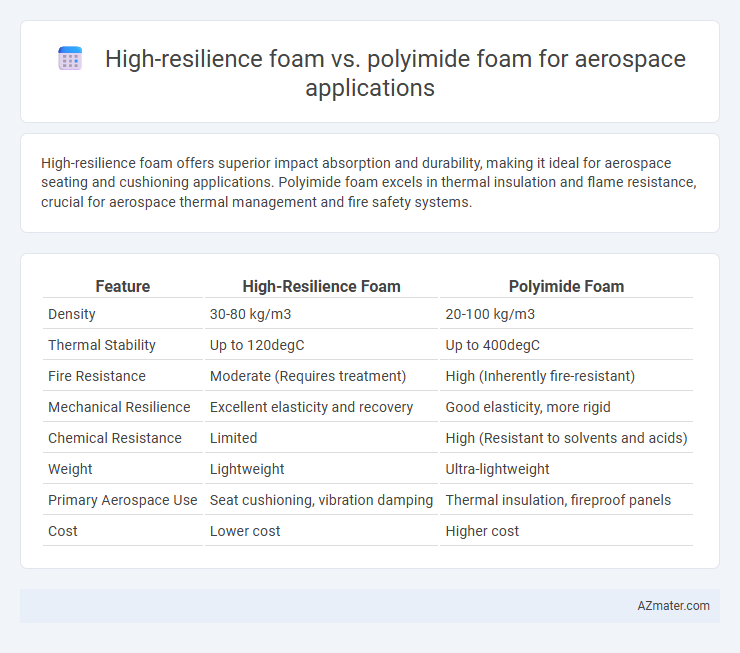High-resilience foam offers superior impact absorption and durability, making it ideal for aerospace seating and cushioning applications. Polyimide foam excels in thermal insulation and flame resistance, crucial for aerospace thermal management and fire safety systems.
Table of Comparison
| Feature | High-Resilience Foam | Polyimide Foam |
|---|---|---|
| Density | 30-80 kg/m3 | 20-100 kg/m3 |
| Thermal Stability | Up to 120degC | Up to 400degC |
| Fire Resistance | Moderate (Requires treatment) | High (Inherently fire-resistant) |
| Mechanical Resilience | Excellent elasticity and recovery | Good elasticity, more rigid |
| Chemical Resistance | Limited | High (Resistant to solvents and acids) |
| Weight | Lightweight | Ultra-lightweight |
| Primary Aerospace Use | Seat cushioning, vibration damping | Thermal insulation, fireproof panels |
| Cost | Lower cost | Higher cost |
Introduction to Aerospace Foam Materials
High-resilience foam offers superior elasticity and energy absorption, making it ideal for cushioning and vibration damping in aerospace applications. Polyimide foam excels in thermal stability and flame resistance, crucial for insulation and fire protection in aircraft structures. Both materials meet stringent aerospace standards but are selected based on specific performance requirements such as weight, durability, and environmental resistance.
Overview of High-Resilience Foam
High-resilience foam offers superior elasticity, durability, and energy absorption, making it ideal for aerospace seating and vibration damping applications. Its open-cell structure enhances breathability and comfort while maintaining shape over time under cyclic loading. Compared to polyimide foam, high-resilience foam balances cost-effectiveness with mechanical performance, though polyimide excels in thermal resistance and fire retardancy.
Understanding Polyimide Foam
Polyimide foam exhibits superior thermal stability and flame resistance compared to high-resilience foam, making it ideal for aerospace applications requiring rigorous safety standards and extreme temperature tolerance. Its cell structure provides exceptional mechanical strength and low outgassing properties, crucial for maintaining integrity in spacecraft environments. This advanced material balances lightweight characteristics with durability, enhancing overall performance in aerospace insulation and cushioning systems.
Key Performance Criteria in Aerospace Applications
High-resilience foam exhibits superior energy absorption and impact resistance, making it ideal for cushioning and vibration damping in aerospace interiors. Polyimide foam offers exceptional thermal stability, flame retardancy, and low outgassing properties, crucial for maintaining safety and performance in extreme aerospace environments. Key performance criteria in aerospace applications prioritize factors such as thermal resistance, mechanical durability, weight reduction, and compliance with stringent fire safety standards.
Weight and Density Comparison
High-resilience foam typically features a density range of 1.6 to 3.0 pounds per cubic foot, offering moderate lightweight properties suitable for aerospace cushioning and vibration damping. Polyimide foam boasts lower density values, often between 1.0 to 2.0 pounds per cubic foot, enabling superior weight reduction critical in aerospace for enhancing fuel efficiency and payload capacity. The significantly lower density of polyimide foam contributes to its advantage over high-resilience foam in applications where minimizing structural weight is paramount.
Thermal Insulation Capabilities
High-resilience foam exhibits excellent thermal insulation properties due to its closed-cell structure, providing efficient heat resistance and durability in aerospace environments. Polyimide foam offers superior thermal stability withstanding extreme temperatures up to 400degC, making it ideal for high-temperature aerospace applications. The choice between high-resilience and polyimide foam depends on specific thermal insulation requirements and operating temperature ranges in aerospace components.
Fire Resistance and Safety Standards
High-resilience foam offers moderate fire resistance but often requires additional treatments to meet stringent aerospace fire safety standards, whereas polyimide foam inherently provides superior flame retardancy and low smoke emission, making it ideal for compliance with FAA FAR 25.853 regulations. Polyimide foam's thermal stability under extreme temperatures enhances occupant safety by minimizing toxic fume release during fires compared to traditional high-resilience foam. These characteristics make polyimide foam the preferred material in aerospace applications demanding high fire resistance and adherence to rigorous safety certifications.
Durability and Longevity in Flight Environments
High-resilience foam exhibits superior compression set resistance and maintains structural integrity under cyclic loading, making it highly durable for aerospace cushions and vibration dampening. Polyimide foam offers exceptional thermal stability and chemical resistance, sustaining performance in extreme flight temperature fluctuations and corrosive environments. The choice between these materials hinges on specific endurance requirements, with high-resilience foam favoring mechanical longevity and polyimide foam excelling in thermal and chemical durability within aerospace applications.
Cost-Effectiveness and Manufacturing Considerations
High-resilience foam offers superior durability and cushioning at a lower production cost compared to polyimide foam, which entails higher raw material expenses and complex manufacturing processes. Polyimide foam provides exceptional thermal resistance and flame retardancy essential for aerospace environments but requires specialized fabrication techniques that increase labor and equipment costs. Choosing between the two materials involves balancing the cost-effectiveness of high-resilience foam with the advanced performance and regulatory compliance benefits of polyimide foam in aerospace applications.
Choosing the Right Foam for Aerospace: High-Resilience or Polyimide?
High-resilience foam offers exceptional durability and energy absorption, making it ideal for aerospace seating and vibration isolation where long-term comfort and support are critical. Polyimide foam provides superior thermal stability and fire resistance, essential for insulation and structural components exposed to extreme temperatures and demanding safety standards. Selecting between high-resilience and polyimide foam depends on prioritizing mechanical resilience for passenger comfort or advanced thermal and fire performance for safety and insulation in aerospace environments.

Infographic: High-resilience foam vs Polyimide foam for Aerospace application
 azmater.com
azmater.com